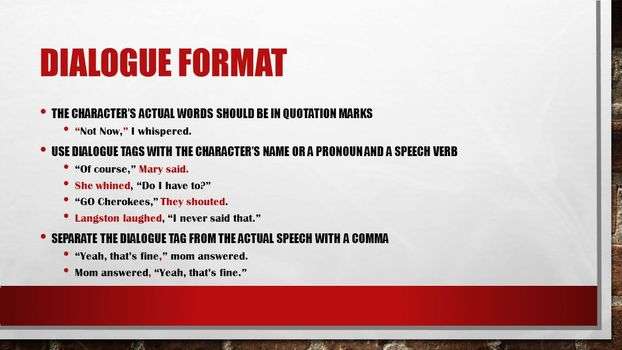Remember that one dialogue that’s still alive in your mind? We grew up with tons of iconic dialogues from our favorite movies. The term “dialogue” refers to communication between two or more persons. If you want your story to be remembered you must master the art of dialogue writing. So, what is dialogue writing? This is why we are here.
Great dialogues move the plot forward, build characters, and deliver insight to readers while seeming genuine and alive. To make a screenplay, novel, or short story continuously engaging, writers should understand several styles of dialogue.
The reader will put it aside if the dialogue is poor. The entire plot of the story will implode on its framework if there are no excellent dialogues. Therefore to have your dialogue writing game is very crucial.
A book isn’t complete without dialogue. In fact, without effective dialogues, you can’t write a good book.
Also read our blogs on :
- What is creative writing? 7 vital tips for you!
- The best guide on what is narrative writing: a 10 min read
- What is technical writing | Importance of technical writing
Table of Contents
What is dialogue writing?
Before we know about what is dialogue writing. Lets’ have a quick thorough on what is dialogue exactly.
What is a dialogue?
Dialogue in a novel, play, or other written material is the interchange of spoken words among two or multiple characters. Lines of dialogue in prose are usually characterized by quote marks and a dialogue tag, such as “they said.” Lines of dialogue in plays are prefixed by the speaker’s name.
Back to the first question- what is dialogue writing?
This kind of writing is nothing but the art and science of making good dialogue delivery to make the story engaging. Following the proper dialogue format makes the writer’s job much easier.
Read more about dialogue : How to Write Dialogue: Formatting, Examples, & Tips

Importance of dialogues in a story
- Conflict is triggered- Verbal words are an excellent approach to convey tension in a work of literature. As a storyteller, you always have the choice of describing the action from a detached third-person point of view; but, you can unleash this conflict and make your movement more alive by using first-person dialogue. Composing dialogue can help you advance your plot, and different styles of speech can be used to convey contrasting viewpoints in your story.
- Creates a presence- Descriptive dialogue is a useful literary method for polishing a character’s voice and defining their point of view and qualities in your readers’ minds. Good conversation should sound like something you’d hear someone say in reality. The gaps and pace of written dialogue should feel natural to your readers and resemble a genuine conversation.
- Showcases characterization- Dialogue is a fantastic way to reveal character. You can acquire a sense of a person’s personality by listening to him or her speak. Not only what they say, but how they say it, can tell if they are educated, funny, cheerful, bored, and much more.
- Increases involvement of readers- Dialogue assists the reader to become immersed in a scene. Rather than having the author or a protagonist inform them about what happened later, they encounter it themselves. It’s more interesting to witness an argument than hearing it out fairly late.
- Exposition is provided- Exposition is background knowledge that your readers should be acquainted with. Character speech is one approach to effectively convey crucial information. Dialogue that is powerful can be utilized to convey both context and character at the same time.
Dialogue writing format

There are certain rules and regulations one needs to follow if they want to have a good outcome. Writing your dialogues following the standard dialogue writing format is always a big YES. Dialogue format can be a difficult undertaking, but with effort and a sharp sense, anyone can accomplish it.
- Each speaker makes a new paragraph- No matter it is just a word or long phrases, every time a character speaks a new paragraph is required.
- Punctuation is contained within quote marks- The punctuation used in a character’s dialogue should be put within the quotations so that the readers may understand how the line was conveyed.
- Make use of dialogue tags- It’s typically enough to use attribution tags—he said, she said, etc.—to show who’s speaking, so avoid the impulse to get inventive.
- To cite something in the dialogue, use a single inverted comma- If a figure mentions something, use single quote marks. Take for example a character say- “ It feels great when she say,’ you are special’.” The single quotation marks state that the statement or phrase is said by someone else.
- Use a period- If the period isn’t part of the quotation, retain it inside the quotation marks. If the quotation ends before the sentence, we can use a comma instead of a period inside the quotation marks.
- For extensive paragraphs, avoid using end quotations- End citations are not allowed in big speeches with multiple paragraphs. The quote marks at the end must be omitted if a character speaks extensively that it spans many paragraphs. Nevertheless, keep in mind that you must start the next paragraph with them.
How to write dialogue

You know what is dialogue writing and the standard dialogue writing format. To better understand the craft let’s learn how to write dialogue writing.
Below are a few steps that can teach you how to write dialogue writing well.
- You should have a logic in each of your dialogue. Each dialogue should have a legitimate purpose. It could just as easily have a meaning or purpose.
- Do not overuse dialogues. Keep the number of unnecessary dialogues to a minimum. The more entertaining and informative your dialogues are, the longer your dialogue’s reading duration gets.
- To avoid wayward dialogue-writing, use storytelling in between dialogues. Keep it brief and straightforward. Between talks, use actions and descriptions to create momentum in the plot.
- Maintain as much realism and proximity to the characters as possible. Maintain a consistent topic or goal throughout. Dialogues should feel like real talks. The less artificial they are, the nicer they will sound.
- Make the narrative interesting and exciting. Don’t forget that good conversation relies heavily on the surprise factor. Keep the characters distinct, and inject one powerful emotion occasionally to keep the discussion fresh and compelling. Make resonant points that people will understand.
Tips for writing excellent dialogues
- Dialogues are the road through which the story moves. Don’t make your dialogues lengthy. Keep them short so that your readers don’t get confused.
- Use simple but attractive language in your dialogues. It’s again about the readability. If your readers fail tto understand your writing, it’s of no use. Complex words makes a writeup look good. That’s a myth! Rather, it feels like you’ve forcefully inserted them. Write your dialgues in understandable language.
- Offer every character a distinct voice or manner of speaking. It will give the character an additional characteristic, and readers will be able to recognize him simply by reading his words.
- After you are done writing your dialogues. Read them loud. Listen carefully how your own dialogues sound. It makes you realize how it will sound to your readers. Make corrections accordingly.
- Minimize the greetings- In the real world, greetings are required. Is it in your book? Not really.Your readers are likely to believe there was some form of greeting. Furthermore, these aren’t normally important elements of your book and hence aren’t required. Greetings in essays, or dialogue writing topic for academic writing is okay. But novels don’t requite them.
Dialogue writing examples
Dialogue writing between two friends
To understand what is dialogue writing better, let’s view some examples. Here we are initiating dialogue writing between two friends. The topic for this short discussion is the very trending- Lockdown.
Shaunak: Hello Preeti. How are you doing? It feels like decades since we last met.
Preeti: Hey Shaunak. I am fine. You say, what’s going on?
Shaunak: I am doing great too. How are you spending your quarantine days?
Preeti-:Well, well, well. Don’t ask! It’s irritating to stay at home 24*7. Moreover, work from home is hectic.
Shaunak: Agreed. However, I am kind of used to it now. The ‘new normal’ as they say.
Preeti: Yeah. Okay so let’s connect over a call one day. Now I got to leave.
Shaunak: Okay. Stay safe. Take care.
The above example was a short conversation between two friends. Let’s have a look at some real examples excerpted from famous novels.
- Forever is True(concluding part of Forever is a Lie) By Novoneel Chakraborty

“Hi, Zin. I wanted to know something really important,” Prisha said.
“Look Prisha, I am really sorry for…”
Prisha interrupted, “I don’t have time for all that, Zin. Just tell me…did you see Saveer’s face on the two occasions that you were here?”
There was silence at the other end. Prisha looked at Saveer in anticipation.
“A lot of things are at stake here, Zin. So, take your time but please answer honestly.” Prisha said.
“No, I didn’t,” Zinnia said. “I was blindfolded both the times. And I was said,’ Do as directed, Zin’. I heard him though. But…”
That was enough for Prisha.
“Thanks. I will call you later.” she cut the call and stood up.
- The dialogue between Tom and his Aunt Polly in The Adventures of Tom Sawyer by Mark Twain.

“There! I might think of that closet. What you been doing in there?”
“Nothing.”
“Nothing! Look at your hands. And look at your mouth. What IS that truck?”
“I don’t know, aunt.”
“Well, I know. It’s jam—that’s what it is. Forty times I’ve said if you didn’t let that jam alone I’d skin you. Hand me that switch.”
The switch hovered in the air—the peril was desperate—
“My! Look behind you, aunt!”
The elderly lady spun around and snatched her skirts from harm’s way. The lad bolted, scrambling up the highboard gate and disappearing through it.
This type of dialogue establishes the whole story and clearly distinguishes the characters.
Conclusion
The addition of conversation to a story can help to bring the plot and its characters to life. While expository paragraphs are useful in setting the mood, a few lines of dialogue can reveal a lot more about the characters.
Designing dialogues can appear difficult initially. With practice, however, it will become part of the routine. Read as much as you can. Practice dialogue writing. Go deep. Mine your emotions.
This puts this blog to a conclusion. I hope you found this interesting and useful.
Happy writing!





 WhatsApp
WhatsApp